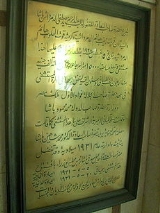
Ain Shams University Faculty of Medicine
Encyclopedia
Ain Shams University, Faculty of Medicine or School of Medicine, is a public Egyptian graduate school and one of the faculties of Ain Shams University
. Now, it is one of the largest educational medical institutions in Africa and the Middle East. It was founded in 1947, making it the third oldest medical school
in Egypt
. It has promoted numerous programs of medical care to serve society, in addition to environmental development and continuous scientific research for local and international health.
It became part of Ain Shams University in the 1950s, when it was established after adding several faculty members. Each year the faculty holds an annual conference dedicated to the recent advances in medical science.
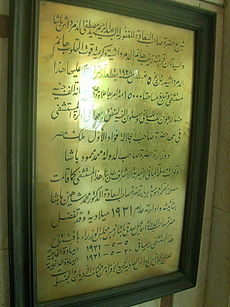
and the Near East journals. It was officially opened on May 5, 1931. The hospital later on became the nucleus around which the Ain Shams Faculty of Medicine and teaching hospitals were formed. A memorial metallic plate and a marble monument were erected to mark this event.

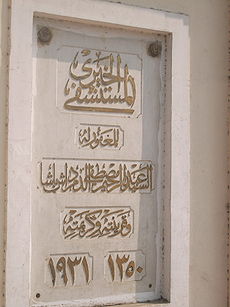
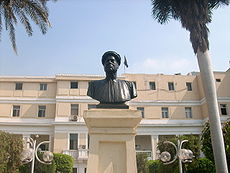 The translation of the metallic plate is: "The honourable late Pasha Abdel-Rahim Moustafa El-Demerdash (may he have all God's forgiveness) and the two ladies his wife Zainab Hanem El-Demerdashiah and his daughter Qout Alqoulob Hanem El-Demerdashiah have donated—on the 5th of August 1928—by the piece of land on which this Hospital was erected which is 15,000 meter square, and donated the sum of 100,000 Egyptian Royal Pounds to be divided as 40,000 for the building of the hospital and 60,000 to be put into a Waqf and its benefits are dedicated to the expenses of running the hospital."
The translation of the metallic plate is: "The honourable late Pasha Abdel-Rahim Moustafa El-Demerdash (may he have all God's forgiveness) and the two ladies his wife Zainab Hanem El-Demerdashiah and his daughter Qout Alqoulob Hanem El-Demerdashiah have donated—on the 5th of August 1928—by the piece of land on which this Hospital was erected which is 15,000 meter square, and donated the sum of 100,000 Egyptian Royal Pounds to be divided as 40,000 for the building of the hospital and 60,000 to be put into a Waqf and its benefits are dedicated to the expenses of running the hospital."
This was in the time of his Royal Highness King Fouad I, king of Egypt, and his Excellency Mohammed Mahmoud Pasha the Minister.
The official royal building authority supervised the building of the hospital. Also the public health authority, headed by his Excellency Doctor Mohammed Shahin Pasha, equipped the hospital and started its management in 1931. His Excellency Ismail Sedky Pasha, the Prime Minister, officially opened the Hospital on May 5, 1931 (outpatient clinic) and on May 20, 1931 (inpatients wards) to offer free treatment for all diseases for all people of all religions and nationalities.
, consists of three faculties and one institute, educational hospitals, outpatient clinics, administration, a library, scientific societies and some medical units.
Dedicated to medical departments and 2 surgical specialities (Cardiothoracic surgery and Ophthalmology).

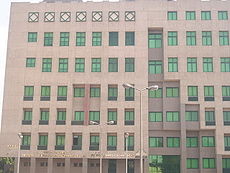
, Histology
, Biochemistry
, Physiology
, Pharmacology
, Pathology
, Parasitology
, Microbiology
, Community Medicine (Community, Environmental & Occupational Medicine), Forensic and Toxicology
. All of the 21 clinical departments are located in the University hospitals, including the 6 major Clinical departments (Ophthalmology
, Ear, Nose and Throat
(ENT), Internal medicine
, Surgery
, Obstetrics
& Gynecology and Pediatrics
).
https://sites.google.com/site/ahmedaliscosmeticsurgerycenter/
Ain Shams University
Ain Shams University is an institute of higher education located in Cairo, Egypt. Founded in 1950, the university provides education at the undergraduate, graduate and post-graduate levels.-History:...
. Now, it is one of the largest educational medical institutions in Africa and the Middle East. It was founded in 1947, making it the third oldest medical school
Medical school
A medical school is a tertiary educational institution—or part of such an institution—that teaches medicine. Degree programs offered at medical schools often include Doctor of Osteopathic Medicine, Bachelor/Doctor of Medicine, Doctor of Philosophy, master's degree, or other post-secondary...
in Egypt
Egypt
Egypt , officially the Arab Republic of Egypt, Arabic: , is a country mainly in North Africa, with the Sinai Peninsula forming a land bridge in Southwest Asia. Egypt is thus a transcontinental country, and a major power in Africa, the Mediterranean Basin, the Middle East and the Muslim world...
. It has promoted numerous programs of medical care to serve society, in addition to environmental development and continuous scientific research for local and international health.
It became part of Ain Shams University in the 1950s, when it was established after adding several faculty members. Each year the faculty holds an annual conference dedicated to the recent advances in medical science.

History
The school of medicine was called el-Demerdash School of Medicine, before establishment of the University. The original El-Demerdash Hospital was established on August 5, 1928 by a generous grant from El-Demerdash Pasha and his wife and daughter. It was built on 12,400 square metres, and had 90 beds and the following sections: quarters for a resident physician and chief nurse, two wards, a surgery unit, out-patient clinic, a laboratory, kitchen, laundry room, isolation ward, an autopsy department and a mosque containing the mausoleum for the El-Demerdash family. The foundation of the hospital was witnessed by many people representing all the society of Egypt and also by the two most powerful figures in the country in that time: Lord George Lloyd (later on George Lloyd, 1st Baron Lloyd), the British high commissioner , and Prime Minister of Egypt Mohamed Mahmoud Pasha. The opening ceremony was covered by Al Ahram, The TimesThe Times
The Times is a British daily national newspaper, first published in London in 1785 under the title The Daily Universal Register . The Times and its sister paper The Sunday Times are published by Times Newspapers Limited, a subsidiary since 1981 of News International...
and the Near East journals. It was officially opened on May 5, 1931. The hospital later on became the nucleus around which the Ain Shams Faculty of Medicine and teaching hospitals were formed. A memorial metallic plate and a marble monument were erected to mark this event.



This was in the time of his Royal Highness King Fouad I, king of Egypt, and his Excellency Mohammed Mahmoud Pasha the Minister.
The official royal building authority supervised the building of the hospital. Also the public health authority, headed by his Excellency Doctor Mohammed Shahin Pasha, equipped the hospital and started its management in 1931. His Excellency Ismail Sedky Pasha, the Prime Minister, officially opened the Hospital on May 5, 1931 (outpatient clinic) and on May 20, 1931 (inpatients wards) to offer free treatment for all diseases for all people of all religions and nationalities.
Location
The faculty of medicine with its hospitals is located in Abbassyia district of Cairo governerate, on Ahmed Lotfy Al-Sayed street.Campus
The campus is located in CairoCairo
Cairo , is the capital of Egypt and the largest city in the Arab world and Africa, and the 16th largest metropolitan area in the world. Nicknamed "The City of a Thousand Minarets" for its preponderance of Islamic architecture, Cairo has long been a centre of the region's political and cultural life...
, consists of three faculties and one institute, educational hospitals, outpatient clinics, administration, a library, scientific societies and some medical units.
Faculties and Institutes
- Faculty of Medicine
- The Faculty of Medicine serves more than 6000 undergraduate students over the 6 years of undergraduate teaching, and more than 1500 post-graduate students (Diplomas, Master of Science in medicine & Medical Doctorate) in various academic and clinical departments. Not only one of the medical schools, but a free (not for profit) hospital serving more than one million patients annually.
- Faculty of Dentistry
- In addition to the educational role, the Faculty of Dentistry provides dental community services.
- Faculty of Nursing
- Focuses on the diagnosis and treatment of human responses to actual or potential health problems.
- Institute of Psychiatry
- A group of faculty and staff dedicated to education and research in psychiatricPsychiatryPsychiatry is the medical specialty devoted to the study and treatment of mental disorders. These mental disorders include various affective, behavioural, cognitive and perceptual abnormalities...
care.
- A group of faculty and staff dedicated to education and research in psychiatric
Buildings Located in The Ain Shams Medical District
Which lyes behind el-Nour mosque in Abbasyyia square in the heart of Cairo, EgyptAin Shams University Educational Hospital
:Image:ASUH3.jpgDedicated to medical departments and 2 surgical specialities (Cardiothoracic surgery and Ophthalmology).
- Medical Inpatient departments (1000 beds)
- Cardiothoracic surgery department (10 inpatient beds, 11 adult cardiac surgery ICU beds, 6 pediatric cardiac surgery ICU beds, 4 Thoracic surgery beds, Blood bank, Lab, Trans-thoracic & Trans-oesophageal Echo, 3 adult cardiac surgery OR, 1 Pediatric cardiac surgery OR, 1 Chest surgery OR, Diagnostic endoscopy unit and Valve surgery followup clinic)
- Emergency department (male and female sections), ECG, X-ray and lab.
- Cardiology department (Coronary care unit, Pediatric cardiology ICU, Cardiac intermediate care unit (225 beds), Inpatient department, Echocardiography, Stress ECG unit, Electrophysiological studies unit, Outpatient clinic)
- Respiratory diseases department (Respiratory diseases ICU, Inpatient, Outpatient, Pulmonary function tests, Respiratory infections lab, Fungal infections lab)
- Dermatology & Andrology department
- Physical medicine department
- Diagnostic radiology department
- Clinical pathology department
- Rheumatology department
- Hematology/Oncology department
- Gastro-enterology/hepatology dpt
- Nephrology department
- Endocrine diseases department
- Neurology department
- Allergy & Clinical Immunology department
- Geriatric medicine department
- Medical ICU (20 beds)
- Geriatrics ICU (10 beds)

Obstetric and gynecology hospital
This hospital was included with the pediatrics hospital in a single building, then was separated in 1963. It is a 7-floored building containing:-
- Outpatient clinics (Infertility, breast disorders, Oncology, Gynecology, Diabetes in pregnancy, Endocrine disorders, Assisted reproductive techniques, Cardiac disorders in pregnancy, Preterm clinic, Cervical smear clinic, clinics) serving more than 40,000 cases annually from all over Egypt (in 1997).
- Inpatient department (580 beds), serving 12,000 deliveries annually and other specialized units (Oncology diagnosis, Fetal ultrasound, Oncology management, Assisted reproductive technology, Urodynamics and laparoscopy units).
- Lab and blood bank service available 24 hours daily.
- Teaching rooms, library, Obstetrics and Gynecology museum.
- Obstetrics and Gynecology intensive care unit (8 beds), Neonatal ICU (36 incubators), 10 delivery rooms and 11 operation rooms.
Pediatrics hospital
Occupying the building of the old obstetrics & pediatrics hospital since 1986 (after building the new obestitrics hospital), until completing the new pediatrics hospital (Construction started 2007). The Pediatrics hospital contains:- Accident & Emergency (A & E) department (for Pediatric Medical & Surgical Emergencies)
- Inpatient department (more than 200 beds)
- Pediatrics Library
- Pediatrics Hemodialysis Unit(since 1991) (12 machines) & peritoneal dialysis units
- Hematology & Oncology unit (Since 1974) and Bone marrow transplantation unit (since 2005) (located in the Nearby Oncology & Radiotherapy building)
- Neonatal & Preterms Intensive Care Unit (since 1995) (19 beds) serving (more than 484 cases annually).
- Pediatric Intensive Care Unit: 12 beds with invasive and non-invasive monitoring, mechanical ventilation (invasive, non-invasive and high frequency oscillation).
- Pediatric surgery department (since 1995): 19 beds Inpatient department & outpatient clinic .
- Diagnostic Radiology unit (Classic radiology, Pediatric echocardiography, Abdominal ultrasound), EEG, Clinical pathology lab, Clinical immunology lab.
- Specialized units (Genetics unit, Pediatric Physiotherapy unit)
- Pediatric specialized Outpatient clinics (Hematology & Oncology clinic, Pediatric Neurology clinic, Pediatric Cardiology & Pulmonology clinic, Diabetes clinic, Endocrine disorders clinic, Allergy & Immunology clinic, Genetic disorders clinic, Clinical nutrition clinic, Hepatology clinic, Disability & Rehabilitation clinic, Polio & Pediatric Orthopedics clinic and Nephrology clinic)
- Immunodeficient isolation unit.
- Vaccination unit.
- Medical nursery and children's club.
El-Demerdash hospital
The original hospital, it was established in 1931. Contains 769 beds and 970 employees (Excluding Professors). It is dedicated to most of the surgical departments; it also contains some diagnostic radiology and clinical pathology units.- General surgery departments.
- Orthopedics
- Department of Neurosurgery
- Urology
- ENT, Audiology & Phoniatrics departments.
- Plastic surgery and Burn management unit.
- Diagnostic radiology units (Neuroradiology, Mammography, etc.)
- Clinical pathology units (Including Histopathology unit)
- Surgical endoscopies unit.
Training & Education Enhancement Center

Educational Hospital
-
- Faculty of Medicine Educational Hospital (internal medicine and surgery) consists of an outpatient clinic and inpatient department. Both have approximately 3200 beds (in 1997), with more than 10,000 staff working in all departments and serving about 2,000,000 patients from all over Egypt annually. It is managed by doctors who are professors of medicine and the other faculty staff in all specializations. The capital of the hospital was estimated to be 6 billion EGP in 1997.
Medical Centers and Outpatient Clinics
- Institute of Psychiatry Hospital.
- Established in 1987. It contains 100 beds, serving about 1000 patients annually at its emergency service, inpatient departments. In addition to the outpatient clinics (Addiction control, Sleep disorders, Psychosexual disorders, Child Psychiatry and Psychogeriatrics/Memory Clinics) and the laboratories (EEG, Sleep disorders and Clinical pathology & psychoactive drug monitoring labs), the center includes departments for Psychologic assessment, Cognitive therapy, occupational therapy, Electro-convulsive therapy and Biofeedback therapy. The Center contain teaching rooms and a specialized library. It was also chosen by the [World Health Organisation] to be the regional center for collaboration in the Eastern Mediterranean region.
- Poison Control Center
- The first poison control and toxicology center in Egypt (established 1981). It contains 26 beds and treats about 25,000 patients annually from allover Egypt. It holds an intensive care unit (8 beds) and a medical analysis laboratory including toxicological screening (providing its services 24 hours). It also has a clinical toxins database providing information to many departments. The center contain an anti-toxin bank. The Center was chosen as the Middle-East representative in the World Federation of Poison Control Centers in 1990.
- Radiation Oncology & Nuclear Medicine Center
- Specialized in diagnosis and treatment of malignant tumors, it contains 28 beds, serving about 19,000 patients annually.
- Medical research center
- A 4 floored building (Established in 1996) containing 24 labs, 2 Animal labs, an isolation & quarantine room, a library, a microfilm center, Computer lab and lecture room. Formerly was the Bilharizial medical research unit, then was dedicated to all medical research.
- Outpatient Clinics
- Receive around 1000 patients daily in all specializations (General and Special Medicine, General and Special Surgery, Pediatrics, Gynecology and Obstetrics, Blood Diseases, Viral Hepatitis, Endoscopes, Vascular Surgery).
- Emergency Departments
- Receive around 500 cases daily and provide 24-hour service.
Ain Shams University Specialized Hospital
-
- Established in 1984 as a self sponsored unit to provide advanced medical care service.
The Cardiac Surgery Academy (CSA)
-
- CSA is an independent establishment, belongs to Ain Shams UniversityAin Shams UniversityAin Shams University is an institute of higher education located in Cairo, Egypt. Founded in 1950, the university provides education at the undergraduate, graduate and post-graduate levels.-History:...
, with a 400 bed capacity, most of them are surgical, also provides many free services.
- CSA is an independent establishment, belongs to Ain Shams University
Intensive care units
-
- Internal MedicineInternal medicineInternal medicine is the medical specialty dealing with the prevention, diagnosis, and treatment of adult diseases. Physicians specializing in internal medicine are called internists. They are especially skilled in the management of patients who have undifferentiated or multi-system disease processes...
, GeriatricsGeriatricsGeriatrics is a sub-specialty of internal medicine and family medicine that focuses on health care of elderly people. It aims to promote health by preventing and treating diseases and disabilities in older adults. There is no set age at which patients may be under the care of a geriatrician, or...
, SurgicalSurgerySurgery is an ancient medical specialty that uses operative manual and instrumental techniques on a patient to investigate and/or treat a pathological condition such as disease or injury, or to help improve bodily function or appearance.An act of performing surgery may be called a surgical...
, TraumaPhysical traumaTrauma refers to "a body wound or shock produced by sudden physical injury, as from violence or accident." It can also be described as "a physical wound or injury, such as a fracture or blow." Major trauma can result in secondary complications such as circulatory shock, respiratory failure and death...
& Surgical ER, NeurologyNeurologyNeurology is a medical specialty dealing with disorders of the nervous system. Specifically, it deals with the diagnosis and treatment of all categories of disease involving the central, peripheral, and autonomic nervous systems, including their coverings, blood vessels, and all effector tissue,...
, Department of Neurosurgery, ToxicologyToxicologyToxicology is a branch of biology, chemistry, and medicine concerned with the study of the adverse effects of chemicals on living organisms...
, CoronaryCoronary heart diseaseCoronary artery disease is the end result of the accumulation of atheromatous plaques within the walls of the coronary arteries that supply the myocardium with oxygen and nutrients. It is sometimes also called coronary heart disease...
, PediatricPediatricsPediatrics or paediatrics is the branch of medicine that deals with the medical care of infants, children, and adolescents. A medical practitioner who specializes in this area is known as a pediatrician or paediatrician...
CardiologyCardiologyCardiology is a medical specialty dealing with disorders of the heart . The field includes diagnosis and treatment of congenital heart defects, coronary artery disease, heart failure, valvular heart disease and electrophysiology...
, Respiratory systemRespiratory systemThe respiratory system is the anatomical system of an organism that introduces respiratory gases to the interior and performs gas exchange. In humans and other mammals, the anatomical features of the respiratory system include airways, lungs, and the respiratory muscles...
, Burns, Cardiothoracic surgeryCardiothoracic SurgeryCardiothoracic surgery is the field of medicine involved in surgical treatment of diseases affecting organs inside the thorax —generally treatment of conditions of the heart and lungs .-Cardiac / Thoracic:...
, Pediatric surgery, ObstetricsObstetricsObstetrics is the medical specialty dealing with the care of all women's reproductive tracts and their children during pregnancy , childbirth and the postnatal period...
& Gynecology, PediatricsPediatricsPediatrics or paediatrics is the branch of medicine that deals with the medical care of infants, children, and adolescents. A medical practitioner who specializes in this area is known as a pediatrician or paediatrician...
, Neonatal.
- Internal Medicine
Departments
The school comprises 10 Academic departments including AnatomyAnatomy
Anatomy is a branch of biology and medicine that is the consideration of the structure of living things. It is a general term that includes human anatomy, animal anatomy , and plant anatomy...
, Histology
Histology
Histology is the study of the microscopic anatomy of cells and tissues of plants and animals. It is performed by examining cells and tissues commonly by sectioning and staining; followed by examination under a light microscope or electron microscope...
, Biochemistry
Biochemistry
Biochemistry, sometimes called biological chemistry, is the study of chemical processes in living organisms, including, but not limited to, living matter. Biochemistry governs all living organisms and living processes...
, Physiology
Physiology
Physiology is the science of the function of living systems. This includes how organisms, organ systems, organs, cells, and bio-molecules carry out the chemical or physical functions that exist in a living system. The highest honor awarded in physiology is the Nobel Prize in Physiology or...
, Pharmacology
Pharmacology
Pharmacology is the branch of medicine and biology concerned with the study of drug action. More specifically, it is the study of the interactions that occur between a living organism and chemicals that affect normal or abnormal biochemical function...
, Pathology
Pathology
Pathology is the precise study and diagnosis of disease. The word pathology is from Ancient Greek , pathos, "feeling, suffering"; and , -logia, "the study of". Pathologization, to pathologize, refers to the process of defining a condition or behavior as pathological, e.g. pathological gambling....
, Parasitology
Parasitology
Parasitology is the study of parasites, their hosts, and the relationship between them. As a biological discipline, the scope of parasitology is not determined by the organism or environment in question, but by their way of life...
, Microbiology
Microbiology
Microbiology is the study of microorganisms, which are defined as any microscopic organism that comprises either a single cell , cell clusters or no cell at all . This includes eukaryotes, such as fungi and protists, and prokaryotes...
, Community Medicine (Community, Environmental & Occupational Medicine), Forensic and Toxicology
Toxicology
Toxicology is a branch of biology, chemistry, and medicine concerned with the study of the adverse effects of chemicals on living organisms...
. All of the 21 clinical departments are located in the University hospitals, including the 6 major Clinical departments (Ophthalmology
Ophthalmology
Ophthalmology is the branch of medicine that deals with the anatomy, physiology and diseases of the eye. An ophthalmologist is a specialist in medical and surgical eye problems...
, Ear, Nose and Throat
Otolaryngology
Otolaryngology or ENT is the branch of medicine and surgery that specializes in the diagnosis and treatment of ear, nose, throat, and head and neck disorders....
(ENT), Internal medicine
Internal medicine
Internal medicine is the medical specialty dealing with the prevention, diagnosis, and treatment of adult diseases. Physicians specializing in internal medicine are called internists. They are especially skilled in the management of patients who have undifferentiated or multi-system disease processes...
, Surgery
Surgery
Surgery is an ancient medical specialty that uses operative manual and instrumental techniques on a patient to investigate and/or treat a pathological condition such as disease or injury, or to help improve bodily function or appearance.An act of performing surgery may be called a surgical...
, Obstetrics
Obstetrics
Obstetrics is the medical specialty dealing with the care of all women's reproductive tracts and their children during pregnancy , childbirth and the postnatal period...
& Gynecology and Pediatrics
Pediatrics
Pediatrics or paediatrics is the branch of medicine that deals with the medical care of infants, children, and adolescents. A medical practitioner who specializes in this area is known as a pediatrician or paediatrician...
).
https://sites.google.com/site/ahmedaliscosmeticsurgerycenter/
Notable faculty graduates
- Prof Ahmed OkashaAhmed OkashaAhmed Okasha M.D., PhD, FRCP, FRCPsych, FACP is an Egyptian psychiatrist. He is a professor of psychiatry at Ain Shams University, Cairo, Egypt...
, President of the Egyptian Psychiatric Association and President of World Psychiatric AssociationWorld Psychiatric AssociationThe World Psychiatric Association is an international umbrella organisation of psychiatric societies.-Objectives and goals:Originally created to produce world psychiatric congresses, it has evolved to hold regional meetings, to promote professional education and to set ethical, scientific and...
(WPA) from 2002 through 2005 - Prof Adel Sadek, psychiatrist, writer and philanthropistPhilanthropistA philanthropist is someone who engages in philanthropy; that is, someone who donates his or her time, money, and/or reputation to charitable causes...
- Prof Ali Khalifa, philanthropist, poetPoetA poet is a person who writes poetry. A poet's work can be literal, meaning that his work is derived from a specific event, or metaphorical, meaning that his work can take on many meanings and forms. Poets have existed since antiquity, in nearly all languages, and have produced works that vary...
and biochemistryBiochemistryBiochemistry, sometimes called biological chemistry, is the study of chemical processes in living organisms, including, but not limited to, living matter. Biochemistry governs all living organisms and living processes...
researcher - Prof Mohammed Fathy Abdel Wahab, scientist of fevers and tropical diseaseTropical diseaseTropical diseases are diseases that are prevalent in or unique to tropical and subtropical regions. The diseases are less prevalent in temperate climates, due in part to the occurrence of a cold season, which controls the insect population by forcing hibernation. Insects such as mosquitoes and...
. - Prof Ahmed Sami Khalifa, pediatric hematologist who was given the National Encouragement Award in Medical Sciences in 1982, and the National Recognition Award in Advanced Technological Sciences in 1998.
- Prof Paul GhaliounguiPaul GhaliounguiPaul Ghalioungui or Ghalioungi , MD , MRCP , Professor of Medicine and former Chairman of Internal Medicine department, Faculty of Medicine, Ain Shams University...
, An Egyptian-Greek internist and medical history writer (Arabic and Pharonic) - Prof Mohammed Sabbour,The father of "Medical Education Development in Egypt", internist, scientist and founder of many medical societies
- Prof Abdel Moniem Ashour, psychogeriatrician, one of the founders of the International Psychogeriatrics Association (IPA), writer and founder of the Al-Zehimer Egypt Association.
- Prof Hamdy El-Sayed, head of Parliament's Health Committee and Chairman of the Egyptian Doctors' Syndicate
- Prof Mohammed Awad Tagg Eldin, respiratory disease professor and former Minister of Health
- Prof Maher Mahran, obstetrician, former Minister for Population and Family Welfare, and former Secretary General of the National Population Council of Egypt
- Prof Ismael Sallam, cardiothoracic surgeon and former Minister of Health and Population from 1996 until 2002, one of the nine candidates for the position of World Health OrganizationWorld Health OrganizationThe World Health Organization is a specialized agency of the United Nations that acts as a coordinating authority on international public health. Established on 7 April 1948, with headquarters in Geneva, Switzerland, the agency inherited the mandate and resources of its predecessor, the Health...
Director-General - Prof Hany Ayyoub, Prof of physiology and discoverer of H-receptors of neurotransmission.
- Prof Mohammed Khairy Abd-Eldayem, Professor of cardiologyCardiologyCardiology is a medical specialty dealing with disorders of the heart . The field includes diagnosis and treatment of congenital heart defects, coronary artery disease, heart failure, valvular heart disease and electrophysiology...
and one of the eminent professors in practice and in education, he recorded Stethoscopy & ECG tapes for teaching undergraduates. - Prof Samy AzerSamy AzerProfessor Samy A. Azer was born in March 1953. He is an Australian Medical Educator who has made an input to Medical Education internationally.-Academic career:...
, Professor of Medical EducationMedical educationMedical education is education related to the practice of being a medical practitioner, either the initial training to become a doctor or additional training thereafter ....
and an eminent international leader in Medical Education and Problem-Based Learning in Australia, Malaysia, Taiwan, Japan, and the USA *Biography. Who's Who in America.. - Prof Aly Abdel Hadi Massoud, Professor of Occupational medicine, Previous Head of the department of Community,Environmental and occupational Medicine, Founder of Egyptian society of Occupational medicine, Egyptian Association of Community medicine.
- Prof Wagida Anwar, Professor of Community, Environmental and Occupational medicine, Previous director of Technical support office of the Egyptian Ministry of Health, Previous director of the Ain Shams University center for Genetic Engineering, Adjunct associate professor of department of preventive medicine and community health University of Texas USA, Fellow of collegium Ramazzin, Marie Curie fellow.
- Prof. Ahmed Ali Hassan is a professor in plastic surgery, Graduated from faculty of medicine ain shams university 1991, Master degree in general surgery 1996 and doctorate degree in 2002. Fellowship in University of Michigan 2000. He has several publications in Aesthetic plastic surgery. He is a member of the international society of aestheic plastic surgery.
External links
- Faculty of Medicine official web site
- Photos of the old school
- Faculty of Dentistry official web site
- Faculty of Nursing official web site
- Institute of Psychiatry official web site.
- Ain Shams University Specialized Hospital official web site
- Cardiac Surgery Academy official web site
- Ain Shams University official web site
- ENT department
- Cardiology department
- Pancreatic Islets transplantation Unit
- Ali Khalifa Diagnostic Oncology Unit
- Department of Neurosurgery

